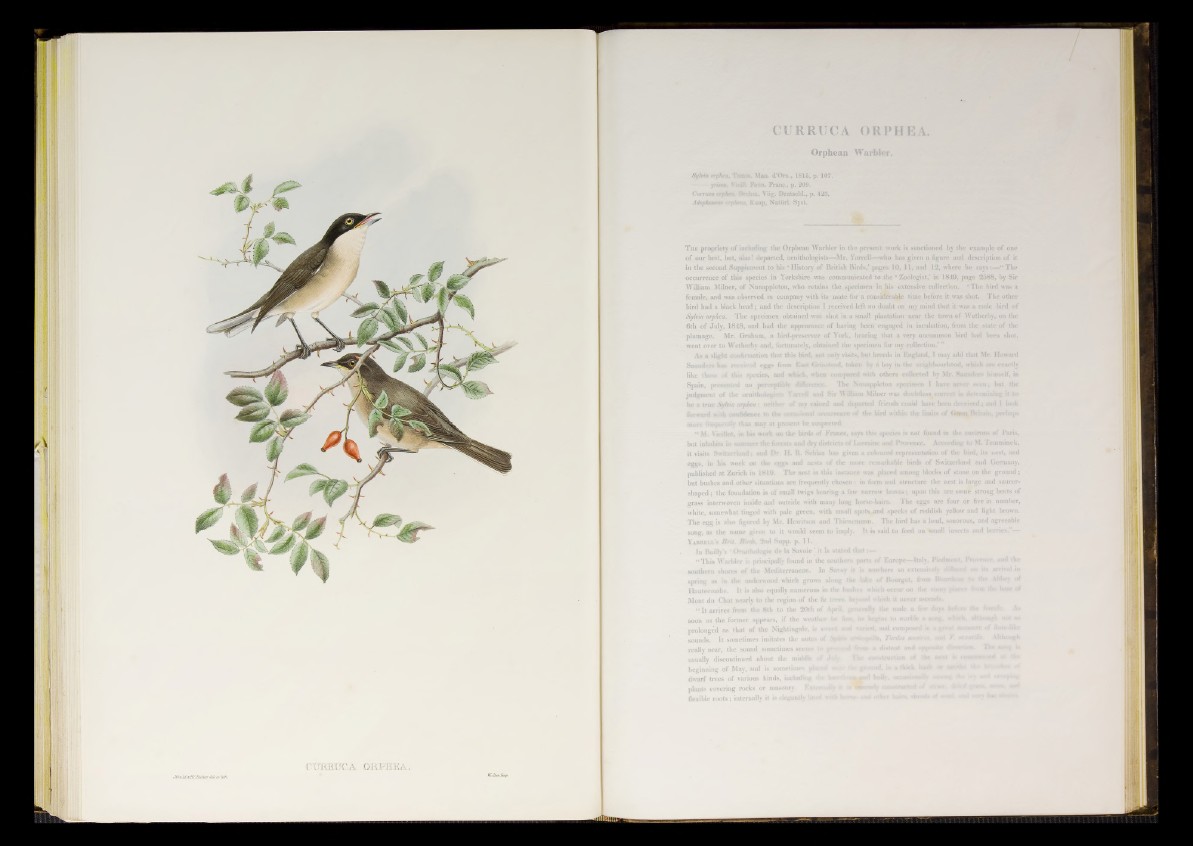
C ï i i R F X f C A O H F H E A .
Sylvia orphea, Temm. Man. d’Orn., 1815, p. 107.
— yriseo, V»iH. Paun. Franç., p. 209.
Curruca orpkva. Brebtn, Vôg. Deotschl., p. 423.
Adophoneuf r-rpheus, Kaup, Natiirl. Syst.
T h e propriety of including the Orphean Warbler in the present work is sanctioned by the example of one
of our best, but, alas! departed, ornithologists—Mr. Yarrell—who has given a figure and description o f it
iu the second Supplement to his 'History of British Birds,’ pages IQ, 11, and 12, where he says:—“ The
occurrence of this species in Yorkshire was communicated to .the ' Zoologist,’ in 1849, page 2588, by Sir
William Milner, of Nunappleton, who retains the specimen in his extensive collection. * The bird was a
female, and was observed in company with its mate for a considérable time before it was shot. The other
bird had a black head ; and the description I received left no doubt on my mind that it was a male bird of
Sylvia orphea. The specimen obtained was shot in a small plantation near the town of Wetherby, on the
6th of July, 1848, and had the appearance of having been engaged in incubation, from the state of the
plumage. Mr. Graham, a bird-preserver o f York, heariug that a very uncommon bird had been shot,
went over to Wetherby and, fortunately, obtained the specimen for my collection.' ”
As a slight confirmation that this bird, not only visits, but breeds in England, I may add that Mr. Howard
Saunders Has received eggs from East Griustcad, taken by a boy in the neighbourhood, which are exactly
like those >»t this species, and which, when compared with others collected by Mr. Saunders himself, in
Spain, presented no perceptible difference. The Nunappleton specimen I have n e 'er seen ; but the
judgment of the ornithologists Yarrell and Sir William Milner was doubtless, correct in determining it to
be a true Sylvia orphea : neither of my valued and departed friends could have been deceived ; and I look
forward with confidence to the occasional occurrence of the bird within the limits of Great Britain, perhaps
“ M. Vieillot, in his work on the birds of France, says this species is not found in the environs of Paris,
but inhabits in summer the forests and dry districts o f Lorraine and Provence. According to M. 'Feminine k,
it visits Switzerland ; and Dr. H. K. Schinz has given a coloured representation of the bird, its nest, and
eggs, in bis work on the eggs and nests of the more remarkable birds of Switzerland and Germany,
published at Zurich in 1819. The nest in this instance was placed among blocks of stone on the ground ;
but bushes and other situations are frequently chosen : in form and structure the nest is large and saucershaped
; the foundation is of small twigs bearing a few narrow leaves ; upon this are some strong bents of
grass interwoven inside and outside with many long borsc-hairs. The eggs are four or five iu number,
white, somewhat tinged with pale green, with small spots .and -specks of reddish yellow and light brown.
The egg is also figured by Mr. Hewitson and Thienemann. The bird has a loud, sonorous, and agreeable
song, as the name given to it would seem to imply. I t is said to feed on small insects and berries.”—
Y a r r e ix s Brit. Birds, 2nd Supp. p. 11.
In Bailly’s ‘ Ornithologie de la Savoie ’ it is stated that :—
“ This Warbler is principally found in the southern parts of Europe—Italy, Piedu»<*ut. Provence, and the
southern shores o f the Mediterranean. In Savoy it is nowhere so extensively did«*
spring as in the underwood which grows along the lake o f Bourget, from Hburdcau
Hautecombe. It is also equally numerous in the hashes which occur on the stony worn toe ***** o>
Mont du Chat uearly to the region of the fir trees, beyond which it never ascends.
“ It arrives from the 8th to the 20th of April, generally the male a few dnjr* M
soon as the former appears, if the weather be one, he begins to warble a song. ***** 8
prolonged as that of the Nightingale, i* sweet and varied, and composed i t -* ***** meaaare of flate-lifci
sounds. I t sometimes imitates the notes of Sipi** atricapufa, 7 urdus mustcu. and t . rcxatuu. Altnoag*
really near, the sound sometimes seems to pMMNpd fro«» a distant and opposHe direction
usually discontinued about the middle >>1 J<J» 1 He construction ot the. MM* » «I
beginning o f May, and is sometime« placed «r
dwarf trees of various kinds, including the
plants covering rocks or masonry, hxiem-ih* «* » «Hwrsety construct«» .« -■
flexible roots ; internally it is elegantly lined *f»h He***- and other hasrs. awreds